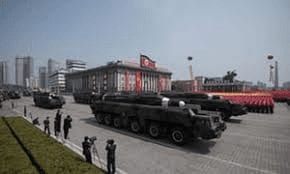North Korea nuclear test site has collapsed and may be out of action – China study By Justin McCurry (theguardian.com) / April 26 2018
Report builds on evidence that site is unstable after sixth nuclear test and puts Kim Jong-un’s pledge to no longer use site in a new light

Chinese experts also flagged the need to monitor for radioactive leaks from North Korea’s nuclear test site. Photograph: Ed Jones/AFP/Getty Images
North Korea’s main nuclear test site has partially collapsed under the stress of multiple explosions, possibly rendering it unsafe for further testing and leaving it vulnerable to radiation leaks, a study by Chinese geologists has shown.
The findings could cast doubt on North Korea’s sincerity in announcing last weekend that it would stop testing nuclear weapons at the site ahead of Friday’s summit between the country’s leader, Kim Jong-un, and the South Korean president, Moon Jae-in.
The test site at Punggye-ri, in a mountainous area in North Korea’s north-east, has been the location for all six of the regime’s nuclear tests since 2006.
The findings, by scientists at the University of Science and Technology of China, suggest the partial collapse of the mountain that contains the testing tunnels, as well as the risk of radiation leaks, have potentially rendered the site unusable.
The study was published soon after Kim said his country would stop testing nuclear weapons and ballistic missiles, and close down Punggye-ri before his meeting with Moon just south of the countries’ heavily armed border.
Nuclear explosions release enormous amounts of heat and energy, and the North’s largest test, in September last year, was believed early on to have rendered the site – a network of tunnels beneath Mount Mantap – unstable.
The Chinese scientists collected collected data for their study following the most powerful of the North’s six nuclear tests, on 3 September.
The controlled explosion, which caused an initial magnitude-6.3 tremor, is believed to have triggered four more earthquakes over the following weeks. The study concluded that eight-and-a-half minutes after the test, there was “a near-vertical on-site collapse towards the nuclear test centre”.

The Chinese university paper, written by Tian Dongdong, Yao Jiawen and Wen Lianxing, said that was followed by an “earthquake swarm” in similar locations.
The yield of the bomb was estimated at more than 100 kilotons of TNT, at least 10 times stronger than anything the North had tested previously. The bomb dropped on Hiroshima in 1945 had a yield of about 15 kilotons.
“In view of the research finding that the North Korea nuclear test site at Mount Mantap has collapsed, it is necessary to continue to monitor any leakage of radioactive materials that may have been caused by the collapse,” the authors said in a summary dated Monday and seen on Wednesday on the university’s website.
The new study is peer-reviewed and has been accepted for publication by the journal Geophysical Research Letters.
The Chinese study made sense and was based on well-understood research, said Rowena Lohman, a seismologist at Cornell University who wasn’t part of the work.
A study published last month by the journal, written by a team led by Liu Junqing at the earthquake bureau in Jilin province along the border with North Korea, found similar results from the September explosion. It described the aftershock that followed seconds later as most likely the “rapid destruction of an explosion-generated cracked rock chimney due to cavity collapse”.
Beijing is particularly concerned about the North’s nuclear tests, since the Punggye-ri site is less than 100km (60 miles) from the border with China.
North Korean nuclear tests have caused seismic events in Chinese border towns and cities, forcing evacuations of schools and offices, sparking fears of wind-borne radiation and leading to a backlash among some Chinese against their country’s unpredictable traditional ally. Chinese authorities have said they’ve detected no radiation risk from the tests.
Kune Yull Suh, a professor of nuclear engineering at Seoul National University, warned last year that further tests could threaten to cause a volcanic eruption at Mount Paektu, which is about 100km away.
On Saturday, Kim announced North Korea would close its nuclear testing facility and suspend nuclear and intercontinental ballistic missile tests – a move welcomed by US president Donald Trump as “big progress” – and which comes ahead of a planned summit between the leaders in late May or early June.
However, Kim stopped short of promising to give up his nuclear weapons, and the missile test ban does not include shorter-range weapons capable of reaching Japan and South Korea.


















